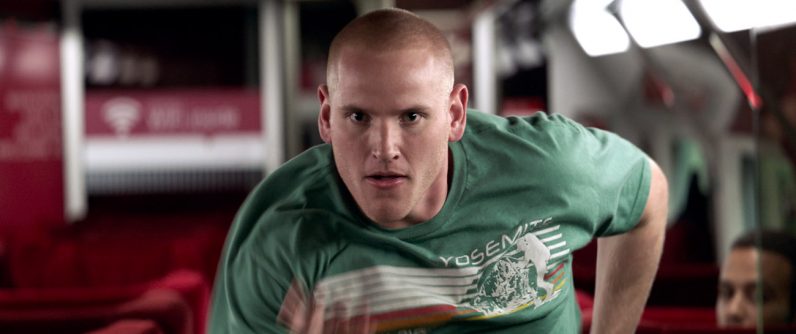
Spencer Stone portrays himself in the movie “15:17 to Paris.” While on a backpacking trip in 2015 through Europe, Stone’s Paris-bound train was attacked by a terrorist and he and two other childhood friends, Anthony Sadler and Alek Skarlatos, were able to subdue him, saving the lives of the more than 500 passengers on board the train. (CNS photo/courtesy Warner Bros.)
NEW YORK (CNS) — The good news about the drama “The 15:17 to Paris” (Warner Bros.), as well as the real-life events on which it’s based, is that, given the right circumstances and motivations, ordinary people can achieve great things.
The bad news is that, when they are not doing so, such everyday folks tend to lead lives that are not of much interest to moviegoers.
Thus, the uneven nature of director Clint Eastwood’s film recounting the circumstances that led up to the thwarting, in August 2015, of a terrorist attack and potential massacre on the train of the title.
[hotblock]
Traveling from Amsterdam to the French capital as tourists, a trio of Americans — Anthony Sadler, Alek Skarlatos and Spencer Stone, who all portray themselves — courageously stop a heavily armed jihadist bent on a shooting spree among the captive passengers. In quelling the assailant, Skarlatos and Stone are able to rely on the training they received, respectively, in the Oregon National Guard and the U.S. Air Force.
Stone also uses his knowledge of first aid to keep a grievously wounded fellow traveler alive as the train races to the nearest station.
The portion of the movie devoted to these headline-grabbing incidents is taut and compelling. But, in adapting the three friends’ book about their exploit and their lives before it, written with Jeffrey E. Stern, screenwriter Dorothy Blyskal fails to evoke much interest in the lads’ humdrum childhoods and fitful careers.
As kids, they have minor skirmishes with their easily provoked teachers. Once grown, they chat about the ups and downs of their professional lives in a way that doesn’t make eavesdropping on them particularly rewarding. They talk sports, trade gentle insults and, once embarked on their European vacation, debate whether to include Paris in their itinerary. Edge-of-your-seat material this is not.
Still, faith and prayer are shown to be an important part of Stone’s life. Twice we see him kneeling at his bedside reciting the “Peace Prayer” often attributed to St. Francis of Assisi. And self-sacrificing heroism is obviously an integral element in the makeup of all three pals.
More honorable than entertaining, “The 15:17 to Paris” reaches an exciting destination. But, in this case at least, getting there turns out to be a good deal less than half the fun.
The film contains gunplay and nonlethal violence, a sequence involving gory wounds, a bit of sexual humor, a couple of uses of profanity and a pair of milder oaths as well as numerous crude and crass terms. The Catholic News Service classification is A-III — adults. The Motion Picture Association of America rating is PG-13 — parents strongly cautioned. Some material may be inappropriate for children under 13.
PREVIOUS: Not enough quality films for families to make a top 10 list
NEXT: Author disputes view that Galileo affair showed church as anti-science



Share this story